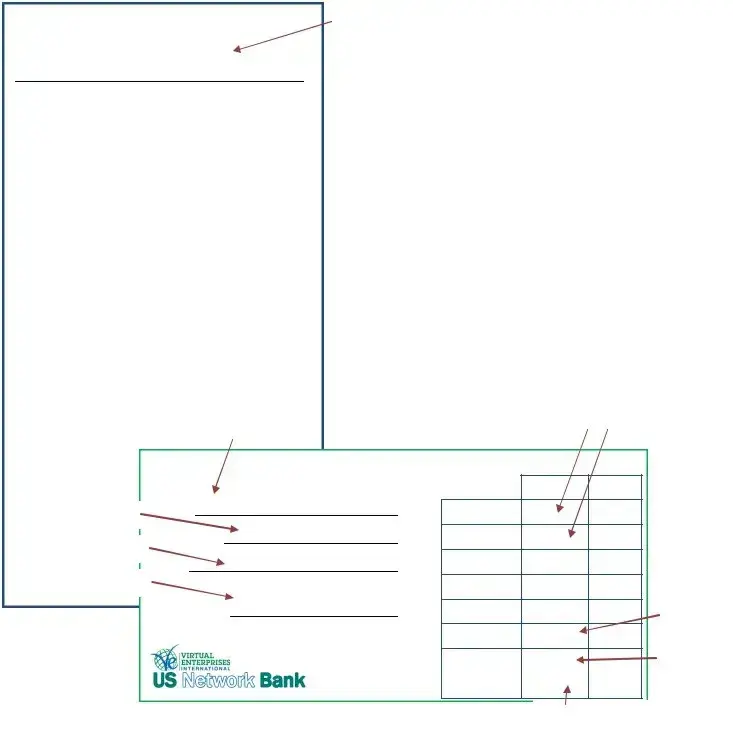EMPLOYEE PAYCHECK, PAYCHECK STUB, AND BANK DEPOSIT SLIP EXAMPLE
To be used with Personal Finance / Task 6: Elements of Your Paycheck and Paycheck Stub, and Depositing Your Paycheck into Your Bank Account
EXAMPLE OF A PAYROLL CHECK AND PAYROLL CHECK STUB
|
|
|
|
|
|
|
|
|
|
|
|
|
|
|
|
|
|
|
|
|
ABC VE Firm |
|
|
|
|
|
|
|
|
Check #: |
|
123 |
|
|
|
|
Payroll Account |
|
|
|
|
|
|
Date: November 1, 20XX |
|
|
|
|
|
|
|
|
|
|
|
|
|
Pay to the order of |
|
Ima Student |
|
|
|
|
|
|
$1,403.56 |
|
|
|
|
One-thousand, four-hundred, three dollars and 56/100 Dollars ————————————————————————- |
|
|
|
|
|
|
Memo: PPE October 31, 20XX |
|
Cash Isking |
|
|
|
|
|
|
|
|
|
|
Chief Financial Officer |
|
|
|
|
|
|
|
|
|
|
|
|
|
|
|
|
|
|
|
|
|
|
|
|
|
|
|
|
|
|
|
|
|
|
|
|
|
|
|
|
|
|
|
|
|
|
|
|
|
|
|
|
|
|
|
|
|
|
|
|
|
|
|
|
|
|
|
|
|
|
|
|
|
|
|
|
|
|
|
Detach check above before depositing and save checkstub below for your records. |
|
|
|
|
|
|
|
|
|
|
|
|
|
|
|
ABC VE FIRM |
|
|
|
|
|
|
|
|
Check #: |
|
123 |
|
|
|
|
|
|
|
|
|
|
Date: November 1, 20XX |
|
Employee: Ima Student |
|
|
|
|
|
|
|
|
|
|
|
|
|
|
|
|
|
|
|
|
|
|
|
|
Pay Period: October 16 - 31, 20XX |
|
|
|
Current |
|
|
|
YTD |
|
|
|
|
|
|
|
|
|
|
|
|
|
|
|
|
|
Gross Earnings |
|
|
$1,680.00 |
|
$18,480.00 |
|
|
|
|
|
|
|
|
Deductions: |
|
|
|
|
|
|
|
|
|
|
|
|
|
|
|
|
|
|
|
Federal Income Tax |
$141.38 |
|
|
|
|
|
|
|
|
|
|
|
|
|
|
|
|
|
Social Security (FICA) |
70.56 |
|
|
|
|
|
|
|
|
|
|
|
|
|
|
|
|
|
Medicare |
24.36 |
|
|
|
|
|
|
|
|
|
|
|
|
|
|
|
|
|
State (CA) Income Tax |
23.34 |
|
|
|
|
|
|
|
|
|
|
|
|
|
|
|
|
|
State Disability Insurance (SDI) |
16.80 |
|
$276.44 |
|
$3,040.84 |
|
|
|
|
|
|
|
|
Net Pay |
|
|
$1,403.56 |
|
$15,439.16 |
|
|
|
|
|
|
|
|
|
|
|
|
|
|
|
|
|
|
|
|
|
|
|
BACK OF PAYCHECK |
|
|
|
|
|
ENDORSE HERE |
|
Recipient’s signature |
|
|
|
DO NOT WRITE, STAMP OR SIGN BELOW THIS LINE |
|
|
|
|
|
|
|
List amount of each item that |
|
|
|
is being depositing. Checks |
|
|
BANK DEPOSIT SLIP |
are entered separately; do |
|
|
not combine. |
|
|
|
|
|
|
Customer’s name |
|
|
|
|
|
|
DEPOSIT SLIP |
|
|
|
|
|
|
dollars |
cents |
|
Customer’s account # |
NAME |
CASH |
|
. |
|
|
|
|
Current date |
ACCOUNT # |
CHECKS |
|
. |
|
|
|
|
|
|
|
DATE |
|
|
. |
|
|
|
|
|
|
Customer’s Signature |
|
|
|
. |
|
|
|
|
|
|
|
SIGNATURE: |
|
|
. |
Sum of items to |
|
|
Subtotal |
|
. |
be deposited |
|
|
|
|
|
Less Cash |
. |
Cash that you |
|
|
|
want back |
|
TOTAL |
. |
|
|
Total amount being deposited into your account


